A new report from the National Transportation Safety Board eviscerates Norfolk Southern (NS) Railroad's handling of the 2023 train derailment in East Palestine, Ohio. The railway made critical mistakes before and (especially) after the derailment. Some of the incompetence can be attributed to poor communication and flawed safety features. But much of it was due to the failure of NS to properly evaluate the relative risk of simply leaving vinyl chloride – the chemical of primary concern – alone vs. blowing up the tank that contained it and setting fire to the gas (1) that came pouring out.
A (very) short lesson in thermodynamics
Most chemical reactions are exothermic; they give off heat. The heat of reaction, aka enthalpy, is measured by a parameter called delta-H. Reactions with high negative delta-H values give off more heat (2). Here are a few examples:

** Delta-H is measured by a unit called kilojoules per mole.
Table 1 should make it obvious that the polymerization of vinyl chloride isn't especially exothermic, yet terms like "catastrophic explosion" were carelessly thrown around at the time, even though such an explosion was unlikely. And there are other reasons, for example, the absence of a catalyst to promote the polymerization (and free radical stabilizers to prevent it - see below).
Here's the reaction:

Vinyl chloride reacts with itself to form PVC via a free radical reaction. But this can be controlled by the addition of free radical stabilizers. As the name suggests, free radical stabilizers aka free radical scavengers, are chemicals that are added to the vinyl chloride to "mop up" any free radicals that may form. A commonly used stabilizer is 4-t-butylcatechol (TBC). (Those with an organic chemistry background should understand why it is used and how it works.)
NTSB pulls no punches
The reason given by NS for blowing up the vinyl chloride-containing cars was to prevent a "runaway" self-polymerization reaction, which could cause a "violent explosion." The NTSB wasn't having any of this. [emphasis mine]
"The [vinyl chloride monomer] in the derailed...tank cars remained in a stabilized environment (that is, was unable to undergo polymerization, a potentially dangerous chemical reaction) until those tank cars were deliberately breached with explosives (the vent and burn procedure). On-scene temperature trends did not indicate that a polymerization reaction was occurring and postaccident examinations confirmed this."
Norfolk Southern Railway Derailment and Hazardous Materials Release East Palestine, Ohio February 3, 2023
Why were the railcars intentionally breached?
This is where the worst mistake was made. NS and its contractors thought they knew what they were doing. They did not.
"NS and its contractors continued to describe polymerization as an imminent threat when expert opinions and available evidence should have led them to reconsider their course of action. NS compromised the integrity of the decision to vent and burn the tank cars by not communicating expertise and dissenting opinions to the incident commander making the final decision."
The "cure" was worse than the disease.
As I have written, vinyl chloride is not an especially toxic chemical. Although it is classified as a carcinogen by the EPA (3), its acute toxicity, as determined by the LD50 in rats given it orally, is well below that of aspirin, caffeine, and acetaminophen and was briefly used as an inhalational anesthetic. However, the same cannot be said for its combustion products. They are much worse. The primary combustion products of vinyl chloride include hydrogen chloride, carbon monoxide, CO2, and phosgene – a deadly gas used as a weapon in World War I.
Bottom line
While no one would choose to live near a wrecked train filled with chemicals, the damage to human health and the environment would have been less (4) had NS followed expert advice. The vinyl chloride should have been left safely in the five cars. Blowing up the cars and burning their contents was an inexcusable error.
NOTES:
(1) Vinyl chloride, which has a boiling point of 8oF, would have become a gas immediately upon release.
(3) Vinyl chloride is classified as a carcinogen, but not from acute exposure. It is an occupational carcinogen. IARC classifies it as a "group 1 carcinogen known to cause hepatic angiosarcoma (HAS) in highly exposed industrial workers."
"Vinyl chloride monomer (VCM) is an IARC (International Agency for Research on Cancer) group 1 carcinogen known to cause hepatic angiosarcoma (HAS) in highly exposed industrial workers."
The same holds true for other conditions that can arise from chronic, but not acute, exposure to the chemical:
"One-time acute exposures to VCM, causing mild symptoms such as dizziness and headaches, have not been proven to propagate long-term effects."
Source: Vinyl Chloride Toxicity
(4) While leaving the vinyl chloride alone would have reduced the damage, some of it was already done once the train derailed. Other chemicals caught fire after the derailment including butyl acrylate, ethylhexyl acrylate, and isobutylene.




